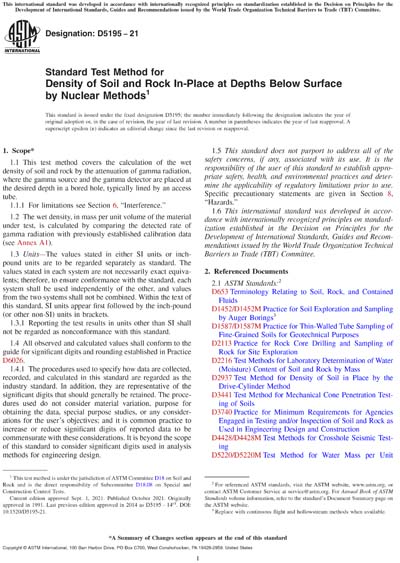Most recent
ASTM D5195-21
Standard Test Method for Density of Soil and Rock In-Place at Depths Below Surface by Nuclear Methods
1.1This test method covers the calculation of the wet density of soil and rock by the attenuation of gamma radiation, where the gamma source and the gamma detector are placed at the desired depth in a bored hole, typically lined by an access tube.
1.1.1For limitations see Section 6, "Interference."
1.2The wet density, in mass per unit volume of the material under test, is calculated by comparing the detected rate of gamma radiation with previously established calibration data (see Annex A1).
1.3Units - The values stated in either SI units or inch-pound units are to be regarded separately as standard. The values stated in each system are not necessarily exact equivalents; therefore, to ensure conformance with the standard, each system shall be used independently of the other, and values from the two systems shall not be combined. Within the text of this standard, SI units appear first followed by the inch-pound (or other non-SI) units in brackets.
1.3.1Reporting the test results in units other than SI shall not be regarded as nonconformance with this standard.
1.4All observed and calculated values shall conform to the guide for significant digits and rounding established in Practice D6026.
1.4.1The procedures used to specify how data are collected, recorded, and calculated in this standard are regarded as the industry standard. In addition, they are representative of the significant digits that should generally be retained. The procedures used do not consider material variation, purpose for obtaining the data, special purpose studies, or any considerations for the user's objectives; and it is common practice to increase or reduce significant digits of reported data to be commensurate with these considerations. It is beyond the scope of this standard to consider significant digits used in analysis methods for engineering design.
1.5This standard does not purport to address all of the safety concerns, if any, associated with its use. It is the responsibility of the user of this standard to establish appropriate safety, health, and environmental practices and determine the applicability of regulatory limitations prior to use. Specific precautionary statements are given in Section 8, "Hazards."
1.6This international standard was developed in accordance with internationally recognized principles on standardization established in the Decision on Principles for the Development of International Standards, Guides and Recommendations issued by the World Trade Organization Technical Barriers to Trade (TBT) Committee.
Content Provider
ASTM International [astm]






